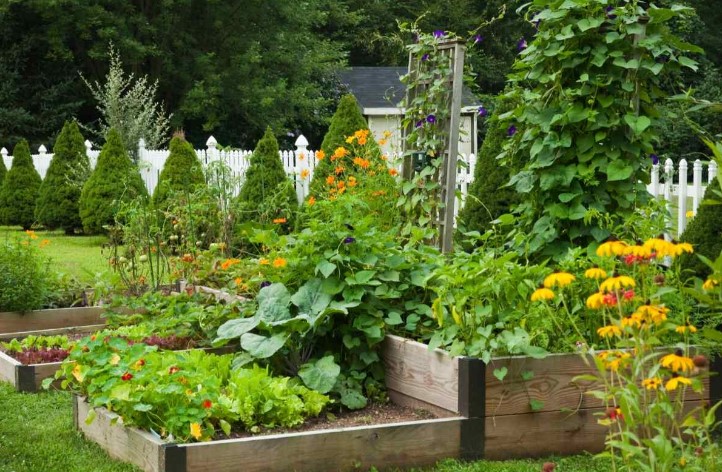Vegetable Garden

Introduction
Definition of a Vegetable Garden
A vegetable garden is a designated area where a variety of vegetables are cultivated. It can range from a small backyard plot to a large community garden. The primary goal is to grow fresh, healthy produce for personal consumption or for sharing with others.
Importance and Benefits of Growing Your Own Vegetables
Growing your own vegetables offers numerous benefits. It provides a source of fresh, nutritious food, helps reduce grocery bills, and offers a rewarding hobby that connects you with nature. Additionally, homegrown vegetables often taste better and are free from harmful pesticides and chemicals commonly found in store-bought produce.
Overview of the Article Structure
This article will guide you through the entire process of starting and maintaining a successful vegetable garden. From planning and soil preparation to planting, watering, and harvesting, we’ll cover every aspect to ensure you can enjoy a bountiful harvest. We’ll also explore advanced techniques, sustainable practices, and share insights from gardening experts.
Planning Your Vegetable Garden
Choosing the Right Location
Sunlight Requirements
Selecting a location with adequate sunlight is crucial. Most vegetables require at least 6-8 hours of direct sunlight each day. South-facing spots are ideal as they receive the most sunlight.
Soil Quality
The quality of your soil directly impacts plant health. Look for well-draining soil rich in organic matter. Conducting a soil test can help determine its composition and necessary amendments.
Proximity to Water Source
A nearby water source makes watering your garden more convenient. Consider installing a rain barrel to collect and utilize rainwater, promoting water conservation.
Deciding the Size of Your Garden
The size of your garden should be manageable and fit your space and time constraints. Beginners might start with a smaller garden and expand as they gain experience.
Selecting the Types of Vegetables to Grow
Seasonal Vegetables
Choose vegetables that thrive in your region’s growing seasons. Cool-season crops like lettuce and spinach do well in spring and fall, while warm-season crops like tomatoes and peppers flourish in summer.
Climate Considerations
Consider your local climate when selecting vegetables. Some varieties are more heat-tolerant, while others prefer cooler temperatures. Research which vegetables are best suited for your area’s climate.
Preparing the Soil
Soil Testing
Importance of Soil Testing
Soil testing is essential to understand your soil’s nutrient levels and pH balance. It helps identify deficiencies and guides you in adding the right amendments.
How to Test Your Soil
You can purchase a soil testing kit or send a soil sample to a local agricultural extension service. Follow the instructions carefully to get accurate results.
Improving Soil Quality
Adding Organic Matter
Organic matter, such as compost, improves soil structure, enhances nutrient content, and increases water retention. Incorporate compost into the soil before planting.
Using Compost and Manure
Compost and well-rotted manure are excellent sources of organic matter. They enrich the soil, promote beneficial microbial activity, and improve plant health.
Soil pH and Nutrient Levels
Balancing Soil pH
Most vegetables prefer a slightly acidic to neutral soil pH (6.0-7.0). Lime can be added to raise pH, while sulfur can lower it. Soil test results will guide you in adjusting pH levels.
Essential Nutrients for Vegetables
Vegetables need macronutrients like nitrogen, phosphorus, and potassium, as well as micronutrients like calcium, magnesium, and iron. Balanced fertilizers can help maintain optimal nutrient levels.
Planting Your Vegetable Garden
Starting from Seeds vs. Seedlings
Pros and Cons of Seeds
Seeds are cost-effective and offer a wide variety of options. However, they require more time and care to germinate and grow into healthy plants.
Pros and Cons of Seedlings
Seedlings provide a head start, reducing the time to harvest. They are more expensive than seeds but are easier for beginners to handle and plant.
Planting Techniques
Row Planting
Row planting involves planting seeds or seedlings in straight lines. This method is suitable for larger gardens and makes weeding and harvesting easier.
Square Foot Gardening
Square foot gardening maximizes space by dividing the garden into small, square sections. Each square is planted with a different vegetable, optimizing yield in limited space.
Spacing and Depth Considerations
Proper spacing ensures plants have enough room to grow and receive adequate sunlight and air circulation. Follow seed packet or plant label instructions for recommended spacing and planting depth.
Companion Planting
Benefits of Companion Planting
Companion planting involves growing certain plants together to benefit each other. It can improve pest control, enhance growth, and increase yields.
Common Companion Plants
Examples of companion plants include tomatoes and basil, beans and corn, and carrots and onions. Research compatible plant pairings for your garden.
Watering and Irrigation
Watering Needs for Different Vegetables
Different vegetables have varying water needs. Root vegetables require consistent moisture, while others, like tomatoes, need deep but infrequent watering.
Best Times to Water Your Garden
Watering in the early morning or late afternoon reduces evaporation and allows plants to absorb moisture before the heat of the day.
Irrigation Systems
Drip Irrigation
Drip irrigation delivers water directly to the plant roots, conserving water and reducing the risk of disease.
Sprinklers
Sprinklers are easy to use and cover large areas. However, they can waste water and increase the risk of fungal diseases if foliage remains wet.
Water Conservation Tips
Mulching helps retain soil moisture and reduces the need for frequent watering. Collecting rainwater and using soaker hoses are other effective water conservation methods.
Fertilizing Your Vegetable Garden
Types of Fertilizers
Organic Fertilizers
Organic fertilizers, such as compost, manure, and bone meal, improve soil health and provide slow-release nutrients.
Chemical Fertilizers
Chemical fertilizers offer precise nutrient formulations but can harm beneficial soil organisms and lead to nutrient imbalances if overused.
How to Apply Fertilizers
Apply fertilizers according to package instructions. Too much fertilizer can damage plants, while too little may result in poor growth.
Frequency of Fertilizing
The frequency depends on the type of fertilizer and the needs of the plants. Generally, vegetables benefit from fertilizing at planting time and again during their growing season.
Signs of Over-Fertilizing
Symptoms of over-fertilizing include leaf burn, wilting, and reduced fruit production. It’s better to under-fertilize slightly than to overdo it.
Pest and Disease Management
Common Garden Pests
Identifying Common Pests
Common garden pests include aphids, caterpillars, slugs, and beetles. Early identification helps in managing infestations effectively.
Natural Pest Control Methods
Natural pest control methods include using insecticidal soaps, neem oil, and introducing beneficial insects like ladybugs and predatory beetles.
Common Plant Diseases
Identifying Plant Diseases
Common plant diseases include blight, powdery mildew, and root rot. Look for symptoms like discolored leaves, spots, and wilting.
Organic Disease Control Methods
Organic methods include crop rotation, using disease-resistant varieties, and applying fungicidal sprays made from natural ingredients.
Preventive Measures
Crop Rotation
Rotating crops helps prevent the buildup of pests and diseases in the soil. Avoid planting the same vegetable in the same spot year after year.
Mulching
Mulching suppresses weeds, retains soil moisture, and can help prevent the spread of soil-borne diseases.
Harvesting Your Vegetables
Signs That Vegetables Are Ready to Harvest
Each vegetable has specific signs that indicate readiness for harvest. For example, tomatoes should be fully colored, while carrots are ready when their tops reach a certain diameter.
Harvesting Techniques
Use proper techniques to avoid damaging plants. For instance, twist and pull root vegetables gently, and use sharp scissors or knives for others.
Post-Harvest Handling
Cleaning and Storing Vegetables
Clean vegetables thoroughly to remove dirt and pests. Store them in a cool, dark place to extend their shelf life.
Preserving Excess Produce
Excess produce can be preserved through canning, freezing, or drying. These methods help you enjoy your garden’s bounty year-round.
Seasonal Gardening Tips
Spring Gardening Tips
Prepare soil early, start seeds indoors, and plant cool-season crops.
Summer Gardening Tips
Water consistently, mulch to retain moisture, and monitor for pests.
Fall Gardening Tips
Plant fall crops, clean up spent plants, and prepare beds for winter.
Winter Gardening Tips
Growing Winter Vegetables
Cold-hardy vegetables like kale and Brussels sprouts can be grown in winter with proper protection.
Protecting Your Garden in Winter
Use row covers, cold frames, and mulches to shield plants from frost and cold winds.
Advanced Gardening Techniques
Raised Bed Gardening
Benefits of Raised Beds
Raised beds improve drainage, reduce soil compaction, and make gardening accessible.
How to Build a Raised Bed
Build a raised bed using untreated wood, bricks, or concrete blocks. Fill with high-quality soil and compost.
Container Gardening
Best Vegetables for Containers
Compact vegetables like lettuce, radishes, and cherry tomatoes thrive in containers.
Tips for Successful Container Gardening
Use containers with drainage holes, choose appropriate potting mix, and water regularly.
Hydroponic Gardening
Basics of Hydroponics
Hydroponics involves growing plants in a nutrient-rich water solution without soil.
Pros and Cons of Hydroponic Gardening
Hydroponics offers faster growth and higher yields but requires a significant initial investment and maintenance.
Sustainable Gardening Practices
Organic Gardening Principles
Organic gardening avoids synthetic chemicals, focusing on natural inputs and sustainable practices.
Permaculture in Vegetable Gardening
Permaculture integrates natural ecosystems into garden design, promoting biodiversity and sustainability.
Composting
How to Compost
Create a compost pile with a mix of green (nitrogen-rich) and brown (carbon-rich) materials. Turn regularly to aerate.
Benefits of Composting
Composting reduces waste, enriches soil, and supports healthy plant growth.
Water Conservation in Gardening
Implementing drip irrigation, mulching, and collecting rainwater are effective ways to conserve water.
Personal Stories and Case Studies
Success Stories from Home Gardeners
Share inspiring stories from gardeners who have transformed their spaces and lives through vegetable gardening.
Case Studies of Community Gardens
Highlight successful community garden projects that promote local food security and community engagement.
Challenges Faced by Beginner Gardeners
Discuss common challenges beginners face, such as pest control and soil quality, and offer solutions.
Expert Insights
Tips from Professional Gardeners
Professional gardeners share their top tips for a successful vegetable garden.
Interviews with Horticulturists
Horticulturists provide insights into advanced gardening techniques and plant care.
Advice from Agricultural Extension Services
Agricultural extension services offer valuable resources and support for home gardeners.
Conclusion
Summary of Key Points
Recap the essential steps for planning, planting, and maintaining a vegetable garden.
Encouragement to Start Your Own Vegetable Garden
Encourage readers to take the first step toward growing their own vegetables and enjoying the many benefits it offers.
Call to Action for Further Education
Invite readers to continue learning about vegetable gardening through books, online resources, and local gardening groups.





